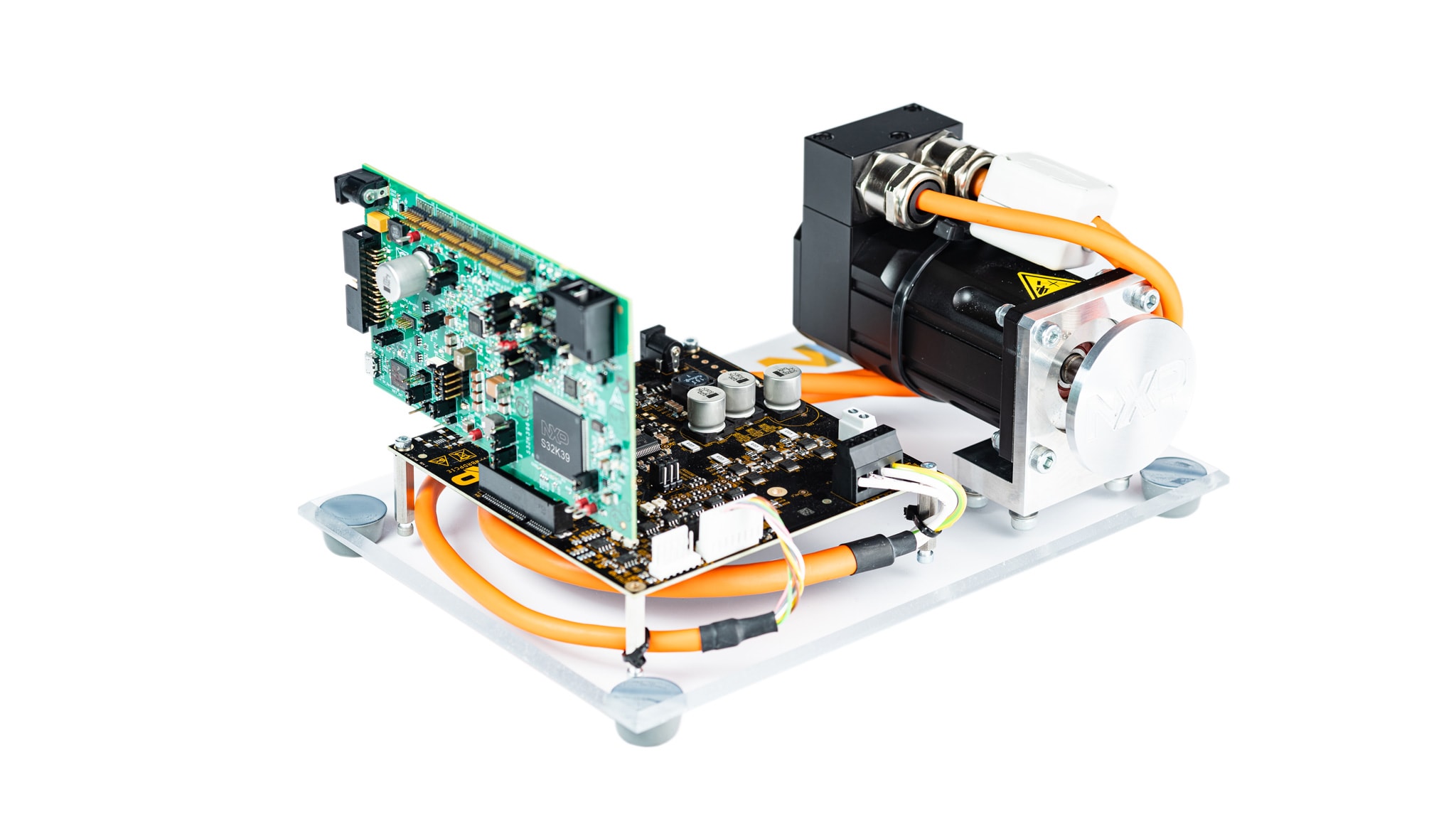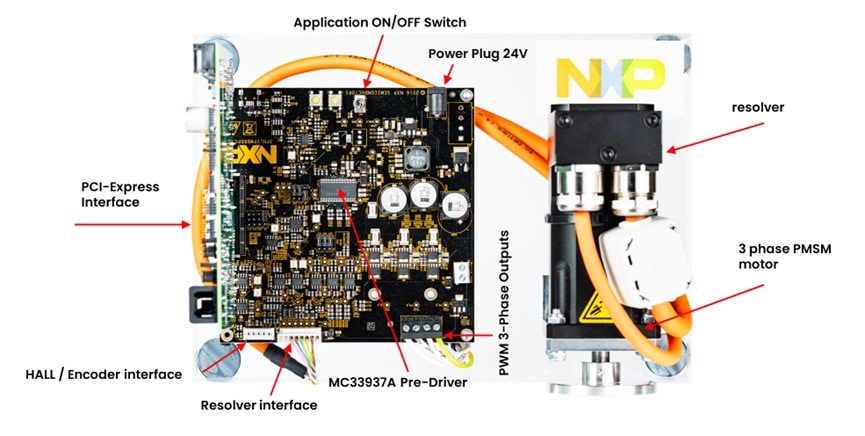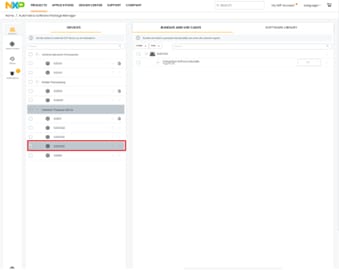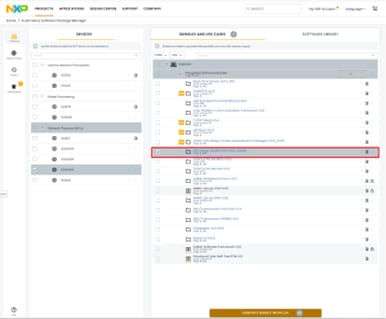Getting Started with the MCSPTR2AK396 Automotive Motor Control Kit
Contents of this document
-
Out of the Box
-
Get Software
-
Plug It In
-
Build, Run
Sign in to save your progress. Don't have an account? Create one.

Purchase your S32K396 BLDC/PMSM Development Kit
1. Out of the Box
- S32K396-PCIe controller board
- 3-phase PMSM/BLDC low-voltage power stage based on the MC33937A pre-driver integrated circuit
- Micro USB cable
- +24 VDC power supply
- Universal adapter
- PSE power cord
- 3 phase PMSM motor with resolver, 30 V per phase, 3000 RPM, 0.32 Nm, 95 W, 5.2 A
2. Get Software
Sign in at nxp.com with your credentials.
2.1 Get S32 Design Studio for S32 Platform IDE
Download and Install S32 Design Studio for S32 Platform v.3.5.
2.2 Download the S32K396 Development Package
Open the Software Package Manager.
- Select the S32K396 in the device column and expand the integrated Software Bundle
- Select S32 Design Studio RTM 3.5.6_D2309 and Generate Bundle Installer
- Install the Bundle Installer to get an S32K396 developmet package (SW32K3_S32DS_3.5.8_D2311.zip)
2.3 Update Platform Packages
- In S32DS, go to Help → S32DS Extensions and Updates from the top menu to open the S32DS Extensions and Updates dialogue
- Update S32 Design Studio Platform and S32 Design Studio PLatform Tools packages
2.4 Install the S32K396 Development Package Into the S32 Design Studio
- In S32DS, go to Help → S32DS Extensions and Updates from the top menu to open the S32DS Extensions and Updates dialogue
- Import S32K396 Development Package by clicking on Add Update Sites link and navigate to
SW32K3_S32DS_3.5.8_D2311.zipfile on your disk - Select and install the S32K396 development package
2.5 Install the RTD drivers
- In S32DS, go to Help → S32DS Extensions and Updates from the top menu to open the S32DS Extensions and Updates dialogue
- Select and install S32K396 RTD AUTOSAR R21-11 Version 3.0.0
2.6 Get FreeMASTER Application Tool
Download and install FreeMASTER Application Tool for real-time debugging.
2.7 Get AMMCLIB for S32K3
Download and install the latest Automotive Math and Motor Control Library set for S32K3 (version 1.1.39 or newer).
2.8 Get the S32K396 Motor Control Application
Download and install the S32K396 motor control application software.
3. Plug It In
3.1 Check the Default Jumper Positions at the 3PHLVPWBRDPCIE Power Stage Board
| 3PHLVPWBRDPCIE Default Jumper Settings | ||
|---|---|---|
| Jumper | State | Notes |
J5 |
2-3 | Resolver S4 output routed to operational amplifier |
J6 |
2-3 | Resolver S3 output routed to operational amplifier |
J7 |
2-3 | Resolver excitation signal from TM5 signal at PCIe connector |
J9 |
1-2 | DC BUS current sensing signal measured via operation amplifier |
J10 |
2-3 | VREF as voltage source for overcurrent threshold potentiometer |
J11 |
1-2 | External overcurrent fault comparator |
J16 |
OPEN | Zero-Cross detection disconnected |
J17 |
OPEN | Zero-Cross detection disconnected |
J18 |
OPEN | Zero-Cross detection disconnected |
J19 |
1-2 | Phase A current signal routed to AN1 signal at PCIe connector |
J20 |
1-2 | Phase B current signal routed to AN3 signal at PCIe connector |
J21 |
1-2 | Phase C current signal routed to AN5 signal at PCIe connector |
3.2 Check the Default Jumper Positions at the S32K396-PCIE-MC Controler Board
| S32K396-PCIE-MC Default Jumper Settings | ||
|---|---|---|
| Jumper | State | Notes |
J11 |
2-3 | CAN0 Transceiver STB signal pulled down |
J13 |
OPEN | FS26_VDEBUG signal generated - FS26 starts in debug mode |
J14 |
CLOSED | FS26_VDEBUG signal derived from VBOS signal |
J15 |
CLOSED | RESET SW2 connected to RESET_B signal |
J16 |
CLOSED | External wake-up signal connected to MCU |
J17 |
2-3 | CAN3 Transceiver STB signal pulled down |
J18 |
1-2, 3-4 | CAN0_TX and CAN0_RX signals routed to on-board CAN transceiver |
J19 |
CLOSED | Functional Safety signals FS0B and FS1B connected |
J20 |
1-2, 3-4 | CAN3_TX and CAN0_RX signals routed to on-board CAN transceiver |
J22 |
CLOSED | RESET_B signal connected as wake-up signal to FS26 |
J23 |
2-3 | VHREF_H voltage connected to VDD_HV_A |
J24 |
CLOSED | RESET_B signal connected to 20-pin JTAG connector |
J26 |
CLOSED | VDD_JTAG signal present at 20-pin JTAG connector |
J28 |
2-3, 5-6, 8-9, 11-12 | JTAG signals routed to S32K3 on-board debugger |
J29 |
OPEN | External RESET signal pins |
J30 |
CLOSED | LPUART2_TX signal connected to S32K3 on-board debugger |
J31 |
1-2 | LPUART2_RX signal connected to S32K3 on-board debugger |
J32 |
1-2 | Sine Wave Generator 1 routed to TM5 signal at PCIe connector |
J33 |
2-3 | V15 voltage regulated by external NMOS transistor |
J35 |
CLOSED | PTB11 connected to TM3 signal at PCIe connector |
J37 |
OPEN | CAN0 Transceiver STB signal not connected to MCU |
J38 |
1-2 | CAN3 Transceiver STB signal not connected to MCU |
In case of using an external JTAG debug probe via J20 connector, change the settings of J28 to 1-2, 4-5, 7-8, 10-11.
4. Build, Run
4.1 Import, Build and Load the Motor Control Application Into MCU
Let's take your MCSPTR2AK396 motor control kit for a test drive.
4.2 Select Application and Project Import
Select the appropriate PMSM motor control application from the installed directory: NXP\MC_DevKits\MCSPTR2AK396\sw.
To import the installed application software project in the S32 Design Studio IDE for S32 Platform:
- Launch S32DS for S32 Platform
- Go to File → Import, then select General → Existing Projects into workspace
- Navigate to the installed application directory:
NXP\MC_DevKits\MCSPTR2AK396\swand choose the appropriate project and click OK - Then, click Finish
4.3 Use Configuration Tool
- Unfold the structure of the project and double-click on *.mex file to open the project configuration in S32 Configuration Tool
- Please ensure that you configure the appropriate project and click "Update Code" button for generating configuration files
4.4 Upload Software and Debug
- In S32DS, return back to the C/C++ perspective
- Use the Debug Configuration menu and select the predefined debug configuration for building and uploading software into MCU
- The S32DS will switch into debug perspective where you may let the code run by clicking Resume (or press F8), and use Disconnect to avoid interference between the S32DS IDE debugger and the FreeMASTER tool
4.5 Set Up the Debugging Tool
Launch the FreeMASTER application.
To open the *.pmpx FreeMASTER project <selected project>\FreeMASTER_control, click File → Open Project.
To enable communication, in the FreeMASTER toolbar, click Go (or press Ctrl + G).
Successful communication displays in the status bar at the bottom as: RS-232 UART Communication;COMn;speed = 115200.
Application Control
Controlling the Application
To spin the motor:
- Select the Speed FOC debug view from the project tree
- Switch to the Control Struct tab in the Motor Control Application Tuning (MCAT) tool tab
- Switch application ON either in MCAT or in variable watch window
- Set the required speed either in MCAT or in the variable watch window
Optionally you may drive the motor speed by SW1 switch and SW3/SW2 push buttons on the power stage board.
- Move the SW1 bar down (out of board direction) to get application ON
- Press SW3/SW2 to initiate clockwise/counterclockwise spinning of the rotor
- Another SW3/SW2 pressing will increase/decrease the motor speed
- Move the SW1 bar up (to the center of board direction) to stop the motor
- Simultaneously pressing SW3 and SW2 will clear the pending faults
See AN14481 Application Note for MCSTR2AK296 - chapter 5 FreeMASTER and MCAT user interface for more details.
Design Resources
Software
-
MCSPTR2AK396 Development Kit Application Software
- Automotive Software Package Manager
- S32K3 Standard Software Package
- S32K3 Reference Software Package
- S32 Design Studio for S32 Platform
- Real-Time Drivers (RTD)
- Automotive Math and Motor Control Library (AMMCLib)
- FreeMASTER Run-Time Debugging Tool
- Motor Control Application Tuning (MCAT) Tool
- Model-Based Design Toolbox (MBDT)
On this page
- 1.1
MCSPTR2AK396 Development Kit Features
- 1.2
Get to Know the S32K396 Controller Board and Power Stage Board
- 2.1
Get S32 Design Studio for S32 Platform IDE
- 2.2
Download the S32K396 Development Package
- 2.3
Update Platform Packages
- 2.4
Install the S32K396 Development Package Into the S32 Design Studio
- 2.5
Install the RTD drivers
- 2.6
Get FreeMASTER Application Tool
- 2.7
Get AMMCLIB for S32K3
- 2.8
Get the S32K396 Motor Control Application
- 3.1
Check the Default Jumper Positions at the 3PHLVPWBRDPCIE Power Stage Board
- 3.2
Check the Default Jumper Positions at the S32K396-PCIE-MC Controler Board
- 3.3
Assemble Controller board to the Power Stage Board
- 3.4
Connect the kit USB and Power Supply




































